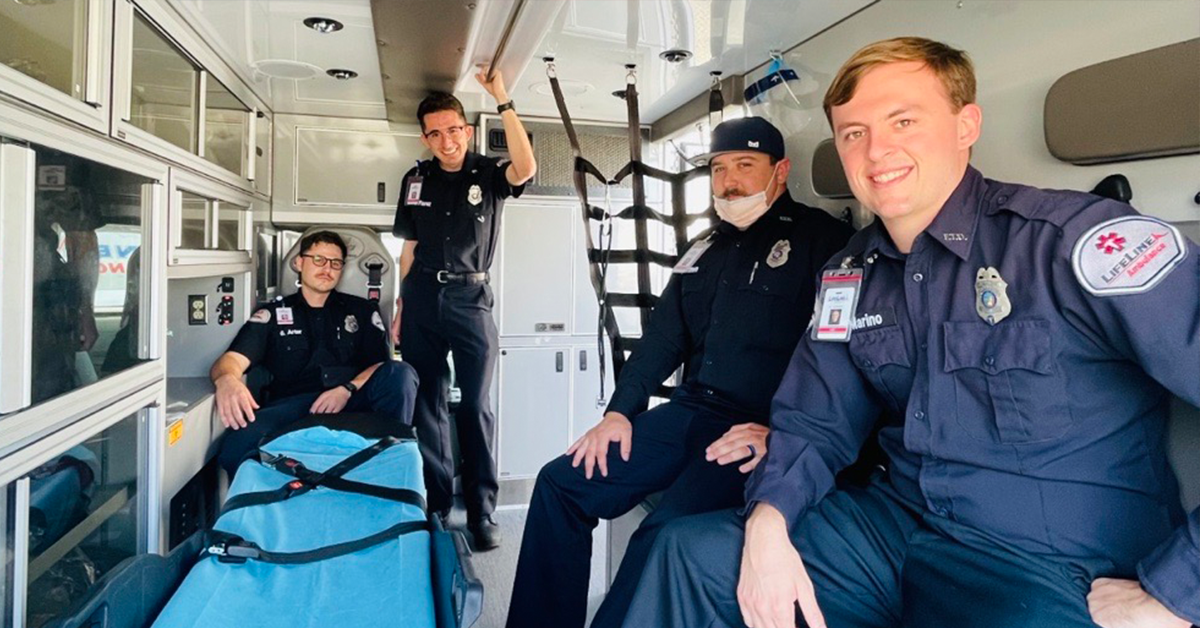Starting a career as an Emergency Medical Technician (EMT) is a rewarding way to enter the field of emergency medical services. However, for those looking to expand their skills, increase their responsibilities, and advance their careers, becoming a Paramedic is the next logical step. Paramedics have a broader scope of practice, advanced medical skills, and greater career opportunities. For EMTs in Los Angeles and Southern California, LifeLine EMS provides a supportive environment for this transition. This article outlines the steps for advancing from EMT to Paramedic and highlights how LifeLine EMS can support your professional growth.
Understanding the Difference Between EMTs and Paramedics
Before diving into the steps for becoming a Paramedic, it’s important to understand the key differences between EMTs and Paramedics. While both roles are essential in emergency medical services, Paramedics have more advanced training and a wider scope of practice.
EMTs (Emergency Medical Technicians):
- Basic Life Support (BLS): EMTs are trained to provide basic life support, including CPR, controlling bleeding, treating shock, and managing fractures.
- Emergency Response: EMTs provide initial assessment, emergency care, and transport for patients.
- Limited Scope of Practice: EMTs are limited in the types of procedures they can perform and the medications they can administer.
Paramedics:
- Advanced Life Support (ALS): Paramedics provide advanced life support, including administering medications, performing intubations, and managing cardiac emergencies.
- Higher Level of Training: Paramedics undergo more extensive training, including anatomy, physiology, pharmacology, and advanced medical procedures.
- Expanded Scope of Practice: Paramedics have a broader range of responsibilities, including advanced airway management, intravenous therapy, and administering a wider range of medications.
Steps to Advance from EMT to Paramedic
Advancing from EMT to Paramedic requires a combination of education, practical experience, and certification. Here are the key steps to help you navigate this professional growth journey:
1. Gain Experience as an EMT
Before pursuing Paramedic training, it’s essential to gain experience working as an EMT. This experience provides the foundational skills needed for more advanced roles and helps you understand the demands of emergency medical services.
- Develop Core Skills: Working as an EMT allows you to hone your skills in patient assessment, basic life support, and emergency response.
- Understand Real-World Scenarios: Experience in the field helps you learn how to handle various emergencies, manage stress, and make critical decisions.
- Build Confidence: Gaining hands-on experience as an EMT builds the confidence needed to take on the more complex responsibilities of a Paramedic.
2. Meet the Prerequisites for Paramedic Training
To enroll in a Paramedic training program, you must meet certain prerequisites. These requirements can vary by program and state, but generally include:
- Current EMT Certification: You must hold a valid EMT certification.
- High School Diploma or GED: A high school diploma or equivalent is typically required.
- CPR Certification: A current CPR certification is usually required, often at the Healthcare Provider level.
- Experience Requirements: Some programs require a minimum amount of field experience as an EMT, typically ranging from six months to two years.
3. Enroll in an Accredited Paramedic Training Program
Once you meet the prerequisites, the next step is to enroll in an accredited Paramedic training program. These programs provide the education and hands-on training needed to become a Paramedic.
- Find an Accredited Program: Ensure the program is accredited by the Commission on Accreditation of Allied Health Education Programs (CAAHEP) or another recognized accrediting body.
- Program Length: Paramedic programs typically take 1-2 years to complete, depending on whether you attend full-time or part-time.
- Coursework: Paramedic programs include coursework in anatomy, physiology, pharmacology, cardiology, medical emergencies, trauma, and advanced life support techniques.
- Clinical Rotations: In addition to classroom instruction, Paramedic training includes clinical rotations in hospitals, emergency departments, and other healthcare settings to gain hands-on experience.
4. Complete Clinical and Field Internships
A crucial component of Paramedic training is completing clinical and field internships. These internships provide real-world experience in various medical settings.
- Clinical Experience: During clinical rotations, you will work in different hospital departments, such as the emergency room, labor and delivery, and intensive care units. This experience helps you develop a deeper understanding of patient care in diverse environments.
- Field Internship: Field internships involve working with experienced Paramedics on ambulances and responding to actual emergency calls. This hands-on experience is critical for developing advanced skills in patient assessment, emergency procedures, and decision-making.
5. Pass the National Registry of Emergency Medical Technicians (NREMT) Paramedic Exam
After completing a Paramedic training program, you must pass the National Registry of Emergency Medical Technicians (NREMT) Paramedic exam to become certified.
- Computer-Based Cognitive Exam: The NREMT Paramedic exam includes a computer-based cognitive test that assesses your knowledge of advanced medical procedures, patient care, and emergency response.
- Psychomotor Exam: In addition to the cognitive exam, you must also pass a psychomotor skills exam that tests your ability to perform advanced medical procedures, such as intubation, IV insertion, and cardiac monitoring.
- State Certification: Once you pass the NREMT exam, you must apply for state certification to practice as a Paramedic in your state.
6. Continue Professional Development
Even after becoming a certified Paramedic, continuing education is crucial for staying current with the latest medical practices and maintaining your certification.
- Continuing Education: Regularly participate in continuing education courses to stay updated on new medical techniques, protocols, and technologies.
- Advanced Certifications: Consider obtaining advanced certifications in specialized areas, such as Advanced Cardiac Life Support (ACLS), Pediatric Advanced Life Support (PALS), or Prehospital Trauma Life Support (PHTLS).
- Professional Development: Attend conferences, workshops, and seminars to network with other professionals and learn about emerging trends in emergency medical services.
The Benefits of Advancing from EMT to Paramedic
Becoming a Paramedic offers numerous advantages, including increased responsibilities, career opportunities, and personal fulfillment. Here are some key benefits:
1. Expanded Scope of Practice
As a Paramedic, you have a broader scope of practice, allowing you to perform more advanced medical procedures and provide higher levels of care. This expanded role can be both challenging and rewarding, offering greater autonomy and the ability to make a more significant impact on patient outcomes.
2. Greater Career Opportunities
Advancing to Paramedic opens the door to a wider range of career opportunities within emergency medical services and beyond.
- Leadership Roles: Paramedics often have the opportunity to move into leadership positions, such as field training officers, supervisors, or operations managers.
- Specialized Medical Roles: Many Paramedics transition into specialized medical fields, such as critical care transport, flight medic roles, or tactical EMS.
- Pathways to Healthcare Careers: Experience as a Paramedic can serve as a stepping stone to other healthcare careers, such as nursing, physician assistant, or healthcare administration.
3. Increased Earning Potential
With greater responsibility comes increased earning potential. Paramedics typically earn higher salaries than EMTs, reflecting their advanced training and skills.
- Higher Pay Rates: Paramedics generally receive higher hourly rates and salaries compared to EMTs, providing greater financial stability and opportunities for growth.
- Overtime and Special Assignments: Many Paramedics have opportunities to earn additional income through overtime, special assignments, or roles that require specialized skills.
4. Personal and Professional Fulfillment
The advanced training and expanded responsibilities of a Paramedic offer a deep sense of personal and professional fulfillment. Knowing that you have the skills and knowledge to make a meaningful difference in people’s lives can be incredibly rewarding.
- Making a Difference: Paramedics often handle more complex cases and provide lifesaving care in critical situations, offering a greater sense of purpose and impact.
- Continuous Learning: The journey from EMT to Paramedic involves continuous learning and growth, keeping your career dynamic and engaging.
How LifeLine EMS Supports Your Journey from EMT to Paramedic
For those in Los Angeles and Southern California, LifeLine EMS offers a supportive environment to help EMTs transition to Paramedic roles. Here’s how LifeLine EMS can assist you in your professional growth:
Comprehensive Training and Development
LifeLine EMS provides access to a wide range of training programs and resources to support your advancement from EMT to Paramedic. Whether it’s hands-on training, scenario-based learning, or specialized courses, LifeLine EMS ensures you’re prepared for the next step in your career.
Mentorship and Guidance
Experienced EMS professionals at LifeLine EMS provide mentorship and guidance to help you navigate your journey from EMT to Paramedic. This support helps build confidence, refine skills, and ensure a smooth transition.
Career Advancement Opportunities
LifeLine EMS offers clear pathways for career advancement, prioritizing internal promotions and providing opportunities for growth within the organization. Whether you aim to become a Paramedic, move into leadership roles, or explore specialized fields, LifeLine EMS is committed to your professional development.
Keep Reading
Want more? Here are some other blog posts you might be interested in.
Emergency Medical Services s a high-stress, physically demanding profession that requires dedication, quick decision-making, and resilience. While the rewards of saving lives...
Emergency Medical Services professionals are often the first point of contact during critical health crises. While technical expertise is essential in emergency...
Emergency Medical Services play a critical role in ensuring the health and safety of communities. In Southern California, including Los Angeles, the...






